Anatomy of Despair: The Holy Bible
From Blackwood to Holy Ground: A Hometown Rebellion
Foreword by RIOT Executive Creative Director and Founder Chris “MUG5” Maguire
It all started in a quiet Welsh mining town, where the discontentment of youth bred a group of misfits destined to turn the music world on its head. Blackwood, a town once fueled by coal and now haunted by its industrial past, gave birth to a revolution—the Manic Street Preachers. Their journey wasn’t just about making music; it was a rebellion against the system, against mediocrity, and against the very notion of conformity.

Executive Creative Director MUG5 on top of Skirrid Fawr, symbolizing the journey of creativity and personal discovery.
I was sixteen years old when The Holy Bible was released, and it was the soundtrack to my bus rides to art college, where I started honing my love of art and my own personal craft. Skipping the traditional college route and jumping straight into university, I was the youngest person in my art class by 2-3 years. Surrounded by more mature minds, I absorbed new perspectives and was constantly inspired by those around me. That time helped shape me as a creative, further fueling my determination to never compromise on artistic vision.

Newport Technical Institute, where MUG5 attended art college and honed his craft. Image by Pwimageglow licensed under CC BY-SA 2.0
Years later, that connection deepened when I found myself in Los Angeles, standing face to face with Jenny Saville’s haunting triptych artwork that graces the cover of The Holy Bible. At The Broad Museum in downtown LA, Saville’s brutal, honest portrayal of the human body struck a chord that reverberated back to the album that shaped a generation.
Twenty-four years after its release, The Holy Bible was calling out to me again.
Balaclavas & Bombshells: The Revolution Televised
In 1994, the Manic Street Preachers didn’t just perform on Top of the Pops—they made a bold social statement, sending shockwaves through mainstream British television. The country watched in stunned disbelief as they took to the stage in balaclavas and military attire. Frontman James Dean Bradfield, his name scrawled across his balaclava in Tipp-Ex, embodied a visual rebellion that reflected everything The Holy Bible stood for. It was a deliberate provocation, a reminder that the Manics were not just a band—they were a political and cultural force, intent on challenging the status quo.
Their performance of “Faster” was designed to be uncomfortable, a sonic and visual disruption of the carefully packaged pop mainstream. The military garb drew immediate comparisons to the IRA, a connection that the band never intended but couldn’t avoid given the tense political climate of the time. The troubles in Northern Ireland were still fresh in people’s minds, and for many viewers, the performance conjured associations with paramilitary groups. The BBC received a staggering 25,000 complaints from viewers, making it one of the most controversial performances in the show’s history.
What was intended as a critique of power structures and societal control was misinterpreted by many, who saw it as a show of solidarity with the IRA. Bradfield later explained that their choice of attire was meant to parody the use of legitimate power, especially by the military and special forces, rather than endorse any form of terrorism. But the damage was done. Sony, their label at the time, feared they’d never be allowed on Top of the Pops again, although the Manics themselves embraced the controversy. This was exactly the kind of cultural disruption they thrived on.
For the Manics, this wasn’t just about creating controversy—it was about using art to provoke thought, to question the world around them. The military garb and balaclavas were extensions of the themes embedded in The Holy Bible: anti-capitalism, anti-war, and anti-complacency. Their performance echoed the chaos and frustration in every lyric and riff on the album, forcing their audience to confront uncomfortable truths. The complaints and backlash didn’t phase the band; they had achieved their goal of shaking the public out of its apathy.
For fans, this moment became iconic—a snapshot of a band unafraid to push the boundaries of what was acceptable in both music and society. The comments on the performance’s YouTube video reveal that for many, it was an introduction to the band’s unapologetic sound and message, and it still resonates with people today. The balaclavas symbolized more than just rebellion; they were a reminder that the Manics were here to provoke, to challenge, and to force the mainstream to reckon with their art.
Looking back, that night on Top of the Pops stands as a defining moment in the Manic Street Preachers’ career. It wasn’t just about the controversy—it was about making a statement. Their performance didn’t just challenge the norms of British television; it cemented the band’s place as one of the most important cultural disruptors of my generation. As one fan commented, “This is PEAK alienation and rage.” And for the Manics, that was precisely the point.
Flesh and Fire: The Violent Beauty of Jenny Saville
It’s impossible to talk about The Holy Bible without acknowledging the stunning, confrontational artwork that wraps its haunting sound in a visual assault on the senses. Jenny Saville, the artist behind the album’s cover, is known for her raw, unflinching depictions of the human body. Her work doesn’t just capture the body—it dissects it, confronts its imperfections, and presents it in all its visceral, wounded glory. For an album as brutal and honest as The Holy Bible, Saville’s art was the perfect match.

Jenny Saville’s monumental triptych on display at The Broad Museum, captured by MUG5. The artwork reflects Saville’s raw, unfiltered representation of the human body, resonating with the themes of The Holy Bible by Manic Street Preachers.
“My paintings are not about what’s pleasant to look at. They are about what is real.” — Jenny Saville
Saville’s painting on the album cover, part of her larger body of work, reflects a deep fascination with the human form—its weight, its texture, its pain. There is nothing idealized about her figures. They are bodies that live and suffer, often in distorted or exaggerated forms. The image chosen for The Holy Bible is no different. It features an abstract triptych of fleshy, fragmented forms, their nakedness stripped of any pretense or polish. It’s unsettling, potentially grotesque but still beautiful and that’s exactly why it works.
The themes explored in Saville’s work resonate deeply with the lyrics of Richey Edwards. Her art mirrors his exploration of self-loathing, mental illness, and the brutal honesty with which he dissected society’s darker truths. Both Saville and Edwards were unafraid to expose the ugly realities of existence, confronting themes like anorexia, body dysmorphia, and the failures of power structures. Just as Edwards’ lyrics are a confrontation with societal decay and personal anguish, Saville’s art presents the body as a battleground for these internal and external conflicts.
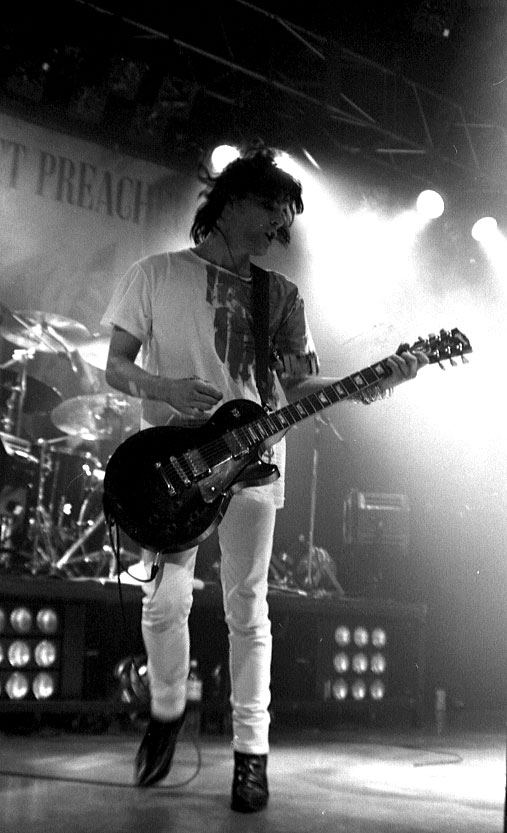
Richey Edwards performing live with Manic Street Preachers. Image by Tim, licensed under CC BY 2.0.
Much like the music within, Saville’s artwork doesn’t shy away from suffering. Instead, it lays bare the complexities of the human condition—beauty found in vulnerability, and power found in fragility. It’s this balance between suffering and survival that makes her art so integral to the album’s identity. The Holy Bible isn’t a passive experience, and neither is Saville’s art. Both demand that the audience confront the harsh truths of existence, forcing the viewer—or listener—to reflect on their own body, their own identity, and the world around them.
“I have always been drawn to bodies that are disjointed and fragile, bodies that don’t fit the norm.” — Jenny Saville
For the Manic Street Preachers, Saville’s art was the perfect encapsulation of the album’s themes. The band saw in her work a reflection of their own artistic ethos: to challenge, to provoke, and to never settle for anything less than raw truth. Saville’s paintings, like the Manics’ music, are beautiful because they are brutal. They do not hide from pain—they reveal it in all its complexity.
In the years since its release, The Holy Bible has been revered as a masterpiece, not only for its music but for the way its cover art complements the themes of the album. Saville’s work continues to provoke and inspire, just as the Manic Street Preachers’ music does. The two, entwined in this singular piece of art, remain a testament to the power of confronting reality head-on, without flinching.
The Ghost in the Lyrics
Some artists bleed for their art, carving pieces of themselves into everything they touch. For the Manic Street Preachers, one figure stood at the heart of this visceral dedication: a lyricist whose battles with mental health, self-doubt, and personal anguish shaped the very soul of The Holy Bible.
Edwards was not just the band’s lyricist; he was their relentless provocateur. And while his words are deeply etched into the fabric of The Holy Bible, they were also carved into his skin—literally. The infamous “4REAL” incident in 1991 remains one of the most brutal displays of his commitment to authenticity. After being accused by a journalist of being disingenuous, Edwards took a razor blade and carved “4REAL” into his arm during the interview. The act required 18 stitches and cemented Richey’s reputation as someone willing to bleed for what he believed in. The message was simple: his art was not up for negotiation.
“I am an architect. They call me a butcher.
I am a pioneer. They call me primitive.
I am purity. They call me perverted.”
— Richey Edwards, “Faster”
That same rawness, that willingness to expose every part of himself, permeates The Holy Bible. Edwards’ lyrics in songs like “4st 7lb” are brutal, intimate confessions of his struggle with anorexia, while tracks like “IfWhiteAmericaToldTheTruthForJustOneDayItsWorldWouldFallApart” take aim at imperialism and capitalism. There was no division between his personal suffering and the political chaos he saw around him. Everything in Richey’s world bled into his lyrics—his pain, his anger, his disillusionment.
But as the band was preparing for what could have been their most successful years, Richey’s struggles intensified. His battles with mental illness, anorexia, and self-harm had reached a breaking point. Despite a stay at The Priory Clinic, his demons continued to haunt him, but rather than shy away from them, Richey poured every ounce of suffering into his writing. The result was The Holy Bible, an album as much about personal destruction as it was about the decay of modern society.
Then, in February 1995, Richey vanished. His car was found abandoned near the Severn Bridge, and though some believed he had taken his own life, no body was ever recovered. The mystery surrounding his disappearance has only added to his legend, transforming Richey from a tortured artist into a mythic figure. Was it suicide, or had he chosen to escape the pressures of fame and expectation? No one knows, and perhaps no one ever will.
“People can’t relate to me because I can’t relate to myself.” — Richey Edwards
The Manic Street Preachers continued, but Richey’s presence looms over everything they do. A microphone remains set up for him at every live performance, a ghostly reminder of the man whose words cut so deeply. His lyrics, filled with anger, vulnerability, and a fierce need for truth, still resonate today. They remain a call to confront the dark realities of the world—and the darkness within ourselves.
Rage Against the Machine: Political Poetry and Lyrical Warfare
The brutal honesty of The Holy Bible wasn’t limited to Richey Edwards’ personal struggles. The album’s lyrics also delivered fierce critiques of political systems, capitalism, and societal complacency, with a rawness that left no room for ambiguity. In 1994, the world was rife with conflict and inequality, and Edwards used his platform to rail against the powers that be, his words cutting deep into the wounds of Western civilization. Today, those same lyrics feel eerily prescient, as if written for the state of the world we now find ourselves in.
One of the album’s most potent political statements comes in the form of “IfWhiteAmericaToldTheTruthForJustOneDayItsWorldWouldFallApart.” It’s a searing indictment of imperialism, systemic racism, and consumerism—forces that Edwards saw as cornerstones of Western hypocrisy. The track rips through these themes with violent precision, calling out the dissonance between what America projects to the world and the darker reality that lies beneath. In an era of rampant social inequality and growing unrest, the song’s message feels just as vital, if not more so, than it did when it was first released.
“The ‘white’ in ‘White America’ refers to the corporate power structure that dominates Western society. The truth, if told, would destroy their world.” — Richey Edwards
Richey’s reverence for poets like Philip Larkin also shines through in these lyrics. Edwards once admitted to envying Larkin’s quiet life—one spent largely in seclusion but with immense cultural impact. Larkin’s disillusionment with society and the futility of life resonated with Richey’s own worldview. Much like Larkin’s poems, Edwards’ lyrics are unflinching in their bleak assessment of the human condition, exposing society’s failures with surgical precision. Both artists shared a fascination with the dark undercurrents of modern existence, though Richey’s expressions came through the lens of political rage.
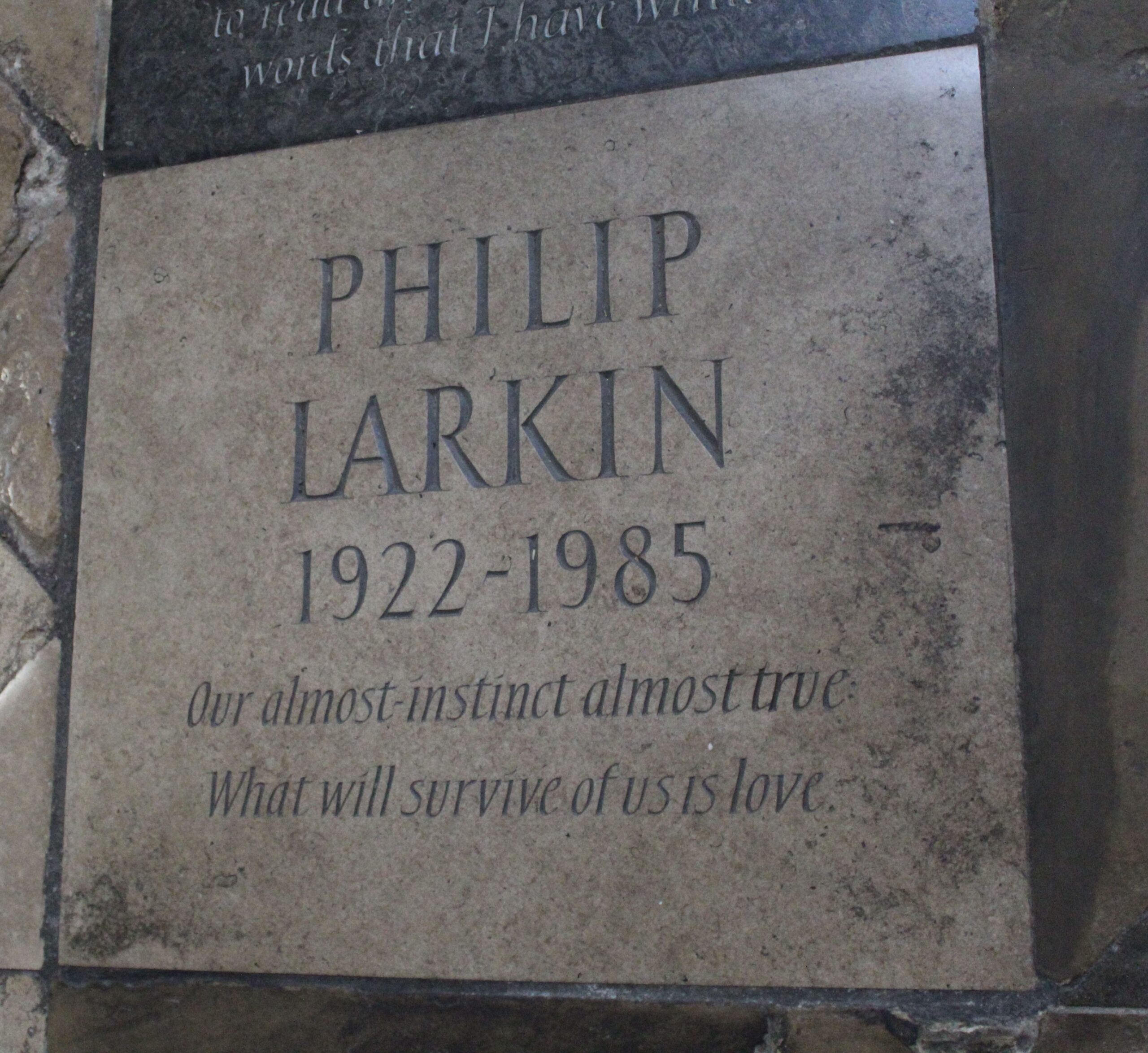
Philip Larkin’s memorial floorstone at Westminster Abbey. The inscription reads, “Our almost-instinct almost true: What will survive of us is love.” Image by 14GTR, licensed under CC BY-SA 4.0
“Our almost-instinct almost true: What will survive of us is love.”
— Philip Larkin, from “An Arundel Tomb“
This quote from “An Arundel Tomb” reflects Larkin’s contemplations on life, love, and what endures after we are gone, making it a poignant connection to Richey Edwards’ own exploration of human fragility and societal decay.
In “Archives of Pain,” Edwards takes on society’s obsession with punishment and revenge, condemning the way violent acts are celebrated in media and culture. The track grapples with the uncomfortable reality that we have become desensitized to violence, with the media feeding our hunger for more blood, more suffering, more spectacle. It’s a chilling exploration of humanity’s darker urges, and one that remains starkly relevant in today’s world, where mass shootings and state-sanctioned violence dominate the headlines.
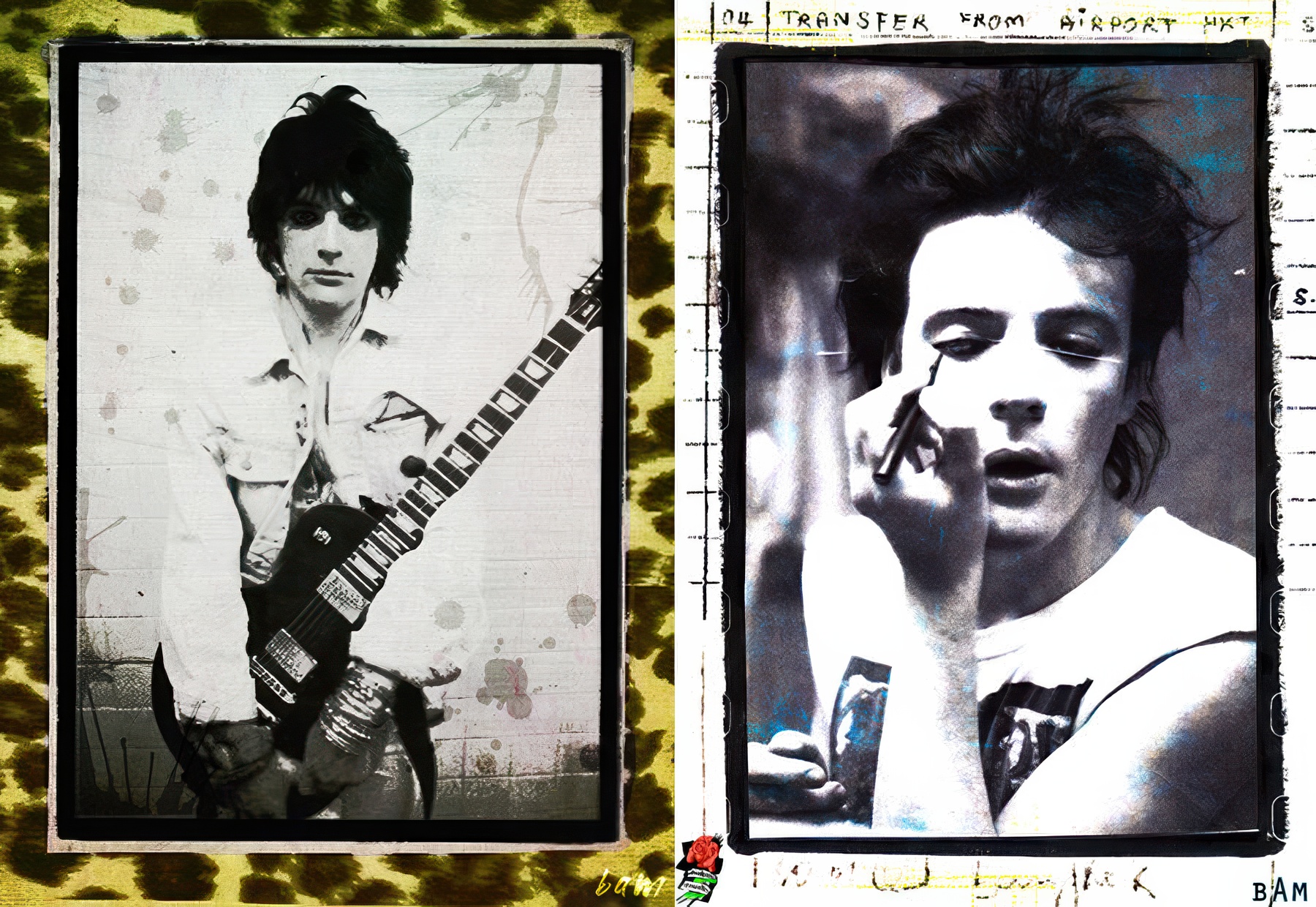
Retrospective of Richey James Edwards. Image created by BamPop, licensed under CC BY-NC-ND 3.0.
“Give me power to cause your pain, To purify you in flames.” — Richey Edwards, ‘Archives of Pain’
Richey wasn’t just reflecting on America—he was also lashing out at the UK where he speaks to the decay of morality in politics, the failures of leadership, and the terrifying normalization of violence and dehumanization. The anger in these tracks is palpable, and the imagery Edwards evokes—describing politicians as walking abortions and calling out the glorification of serial killers—forces listeners to reckon with the deep corruption of institutions.
Much like his personal battles, Richey’s political lyrics were confrontational, unapologetic, and designed to force reflection. He wasn’t interested in providing answers or offering hope—his goal was to shine a light on the rot and expose the truth, no matter how uncomfortable it was. That unfiltered rage is what gives The Holy Bible its continued power as both a personal and political statement. For fans and critics alike, it’s these themes that continue to resonate decades after the album’s release. At a time when political and social systems seem more fragile than ever, The Holy Bible stands as a powerful reminder that art can be a tool of resistance, a way to confront the systems of power that seek to control and divide. Edwards’ lyrics, full of pain and anger, remind us that the fight against complacency and corruption is ongoing—and that the most powerful art is often born out of struggle.
“Who’s responsible? You fucking are.” — Richey Edwards, ‘Of Walking Abortion’
The Studio as a Battlefield
Recording The Holy Bible wasn’t just an artistic endeavor—it was a psychological battleground. The sessions, held in Cardiff’s Sound Space Studios in late 1993 and early 1994, saw the band submerged in a dark creative headspace. The Manic Street Preachers were grappling with disillusionment, anger, and the weight of Richey Edwards’ increasingly fragile mental state. All of these factors conspired to shape the sound and tone of what would become one of the band’s most harrowing and critically acclaimed albums.
The album was produced by Steve Brown, who gave the Manics full creative control, allowing their unfiltered vision to come through. Brown’s minimalist production stripped the songs down, reflecting the rawness of the material. His approach let the aggression of the instrumentation and the confrontational lyrics take center stage. But it wasn’t just the band’s performances that amplified the album’s intensity—the samples scattered throughout reinforced the record’s bleak worldview.
“Recording The Holy Bible felt like exorcising a demon. Every take felt more intense than the last. It was emotionally draining for all of us.” — James Dean Bradfield
Each sample—ranging from political speeches to historical commentary—was carefully chosen to highlight themes of violence, control, and societal decay. Take the opening track, “Yes”, where a male voice coldly declares: “Everything’s for sale.” This chilling statement sets the tone for the entire album, offering a critique of how capitalist society commodifies human life and exploits the vulnerable.
One of the album’s most potent political statements comes in “IfWhiteAmericaToldTheTruthForJustOneDayItsWorldWouldFallApart.” The track opens with a sample from a British news report discussing an upcoming gala between Ronald Reagan and Margaret Thatcher. The formal setting between two of the most powerful Western leaders mirrors the societal hypocrisy Edwards rails against—glossing over inequality, segregation, and imperialism with pomp and diplomacy. The sample underscores the track’s scathing critique of American imperialism, systemic racism, and consumerism.
“Faster” opens with a chilling sample from the film 1984, where a character says: “I hate purity, I hate goodness. I don’t want virtue to exist anywhere. I want everyone corrupt.” This sets the tone for the song’s ferocious rejection of societal control and the suffocating pressure to conform, reflecting the band’s broader political rage.
Perhaps the most harrowing sample appears in “The Intense Humming of Evil,” which begins with a voiceover from the Nuremberg Trials. A Nazi officer recounts his crimes, forcing the listener to confront the atrocities of human history. This sample ties directly into the album’s themes of institutionalized violence and oppression, serving as a chilling reminder of the horrors that continue to haunt society.
“I wanted the album to sound like it had no escape. Every note, every word, every beat had to feel like there was no way out.” — Steve Brown
“Archives of Pain” features a sample from a 1980 interview on BBC’s Newsnight with Irene MacDonald, a mother of a murder victim. In the interview, MacDonald denounces the killer with the words: “I wonder who you think you are. You damn well think you’re God or something? God give life, God taketh it away, not you. I think you are the Devil itself.” The sample introduces a track that grapples with society’s obsession with punishment and vengeance.
The intro sample for “Of Walking Abortion” comes from an interview with Hubert Selby Jr., the author of Last Exit to Brooklyn and Requiem for a Dream. In the sample, Selby expresses a bleak condemnation of societal decay, aligning perfectly with the song’s themes of right-wing totalitarianism, human cruelty, and the self-destruction of society. Selby’s dark reflection on human nature mirrors the band’s critique of authoritarianism and violence.
One of the album’s most personal tracks, “4st 7lb”, offers a haunting reflection of Edwards’ battle with anorexia. The title refers to the weight at which death becomes inevitable, and the song’s painfully raw lyrics document a slow descent into body dysmorphia and self-destruction. This track, perhaps more than any other, demonstrates how closely the album’s themes were tied to Edwards’ own turmoil.
The recording process was marked by emotional intensity and mental strain, with the band operating in a near-claustrophobic environment. Edwards was battling anorexia, alcoholism, and self-harm throughout the sessions, and the emotional toll of these struggles bled into his performance. Despite his physical and mental struggles, his presence loomed over every moment, shaping the record’s deeply personal and political narrative.
Ultimately, the album stands as a testament to the band’s dedication to confronting uncomfortable truths. The Holy Bible wasn’t just an album—it was a deeply cathartic release, channeling both personal and global chaos into a work of raw, unrelenting honesty.
Cultural Shockwaves: Reception and Legacy of The Holy Bible
When The Holy Bible was released in August 1994, it wasn’t just an album—it was a punch to the gut. While previous Manic Street Preachers albums had their moments of defiance, none cut as deeply or with as much precision as this one. It was uncompromising, harrowing, and completely unafraid to tackle subjects that were often ignored in mainstream rock. But this lack of compromise meant the album didn’t immediately find a comfortable home in the charts.
The initial reception was mixed. While fans admired the band’s commitment to brutal honesty, critics were divided. Some praised its raw intensity, while others found it too difficult to digest. One thing was clear: The Holy Bible demanded attention. It wasn’t an album that allowed casual listening—it required confrontation, reflection, and emotional resilience.
“It’s not just an album—it’s a mirror to the darkest parts of our society and ourselves.” — Nicky Wire
Critically, the album has since gained a towering reputation. Retrospective reviews frequently hail it as one of the most important and challenging records of the 1990s. NME, who originally gave it a positive review, has listed it among the greatest albums of all time. Q Magazine called it a “fearless, intense masterpiece” that encapsulated the darkness of the human condition like few other albums before or since.
More than 25 years later, The Holy Bible resonates just as fiercely. Its commentary on politics, consumerism, body image, and mental illness has only grown more relevant with time. Many listeners have found new meanings in the lyrics, particularly as the world has witnessed increasing political turmoil and social inequality. Tracks like “IfWhiteAmericaToldTheTruthForJustOneDayItsWorldWouldFallApart” feel as timely today as they did in 1994, resonating with a new generation of listeners looking for raw honesty and unfiltered emotion in their music.
The Vanishing Ghost: Richey Edwards and the Aftermath
On February 1, 1995, less than six months after the release of The Holy Bible, Richey Edwards disappeared. His car was found abandoned near the Severn Bridge, a notorious suicide spot, but no body was ever recovered. Edwards had been battling severe mental health issues, including anorexia, self-harm, and depression, and his disappearance left a haunting void, both in the band and for fans around the world.
For many, Edwards’ disappearance only deepened the connection to The Holy Bible, an album that had already laid bare his inner turmoil. His lyrics, filled with themes of pain, alienation, and societal decay, felt like a cry for help in retrospect. The unresolved mystery surrounding his disappearance added a mythic dimension to his legacy, cementing his place as one of rock’s most enigmatic and tragic figures.
Edwards’ disappearance remains unsolved, but his impact on the band—and on music—endures. To this day, a microphone is left on stage for him during live performances, a poignant reminder of the void he left behind. The Holy Bible, with its searing honesty and emotional intensity, stands as his final artistic statement, a window into a brilliant but tortured mind that the world lost too soon.
Surviving the Abyss: The Manics After The Holy Bible
After Richey Edwards’ disappearance, the future of the Manic Street Preachers was uncertain. Some believed the band would dissolve under the weight of the tragedy, but instead, the remaining members—James Dean Bradfield, Nicky Wire, and Sean Moore—chose to press on. The loss of their lyricist and friend left an indelible mark on the band’s direction, but instead of retreating into the darkness that had defined *The Holy Bible*, they chose a different path.
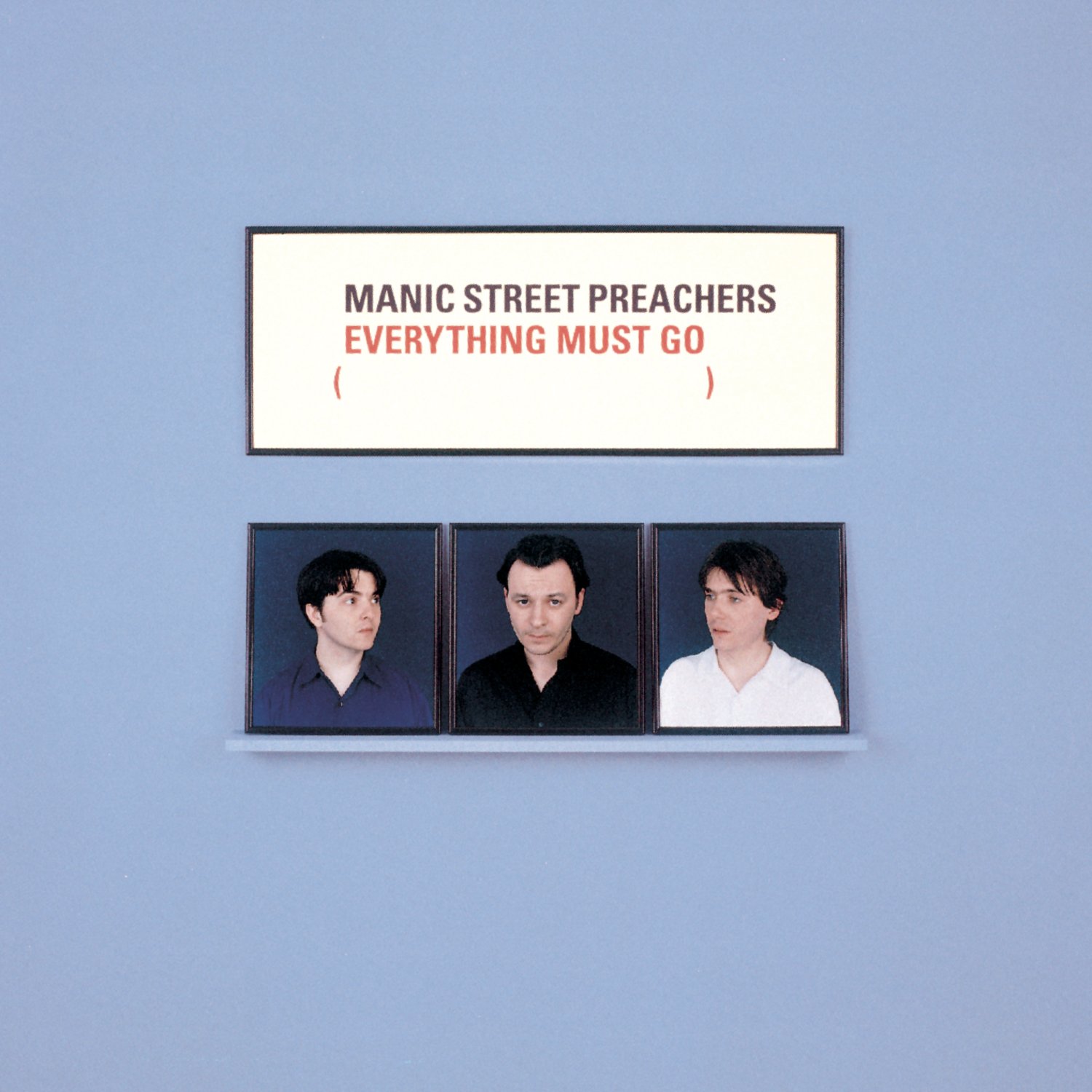
Album cover of Manic Street Preachers’ Everything Must Go* Image courtesy of IMDb. View original here.
Their first album post-Richey, Everything Must Go (1996), marked a major shift in sound and tone. Gone were the scathing, raw lyrics of societal decay and personal anguish. In their place was a more anthemic, accessible sound, with a hopeful undercurrent. While some of the lyrics on Everything Must Go were still penned by Edwards—his words appearing on tracks like “Elvis Impersonator: Blackpool Pier” and “Small Black Flowers That Grow In The Sky”—the majority of the album was written by Nicky Wire, whose more reflective and sometimes wistful writing helped the band transition into a new era.
Everything Must Go was a critical and commercial success, a stark contrast to the reception of The Holy Bible. It introduced the Manics to a broader audience and proved that they could survive, and even thrive, after such a profound loss. The album’s title itself suggested a purging of the past, a need to move forward while still honoring what had come before.
“We didn’t want to continue wallowing in despair. Everything Must Go was about survival, about finding light after the darkest time.” — Nicky Wire
As the band evolved, so did their sound. Later albums like This Is My Truth Tell Me Yours (1998) and Lifeblood (2004) saw the band experimenting with more polished, introspective themes, with lyrics reflecting on politics, identity, and the passing of time. But despite their shift in sound, the shadow of Richey Edwards—and the raw energy of The Holy Bible—remained a presence in the band’s legacy. In later interviews, the band members often spoke of how Richey’s absence continued to inform their music and their lives.
The Manic Street Preachers had not just survived the abyss—they had redefined themselves, proving that while they had lost a central part of their creative soul, they could continue to make music that resonated with both new and longtime fans. Through it all, The Holy Bible remained a touchstone in their catalog, a dark masterpiece that symbolized their rawest, most unflinching expression of art.
The Art That Survives
More than two decades after its release, The Holy Bible continues to resonate, not just as an album but as a work of art that demands engagement and reflection. Its unflinching exploration of personal pain, political decay, and societal collapse has solidified it as a timeless masterpiece—one that still echoes in the chaos of our current world.
At RIOT creative agency, we believe in the power of art to confront and transform. Just as The Holy Bible forced its listeners to look deeply into the void and ask uncomfortable questions, we strive to create work that challenges, provokes, and, above all, leaves a lasting impact. The Manic Street Preachers didn’t settle for mediocrity; they pushed boundaries, and in doing so, created something that transcended the music of their time.
Whether through music, design, or film, the legacy of artists like Richey Edwards and the Manic Street Preachers reminds us that the art that survives is the art that dares to be raw, real, and fearless.

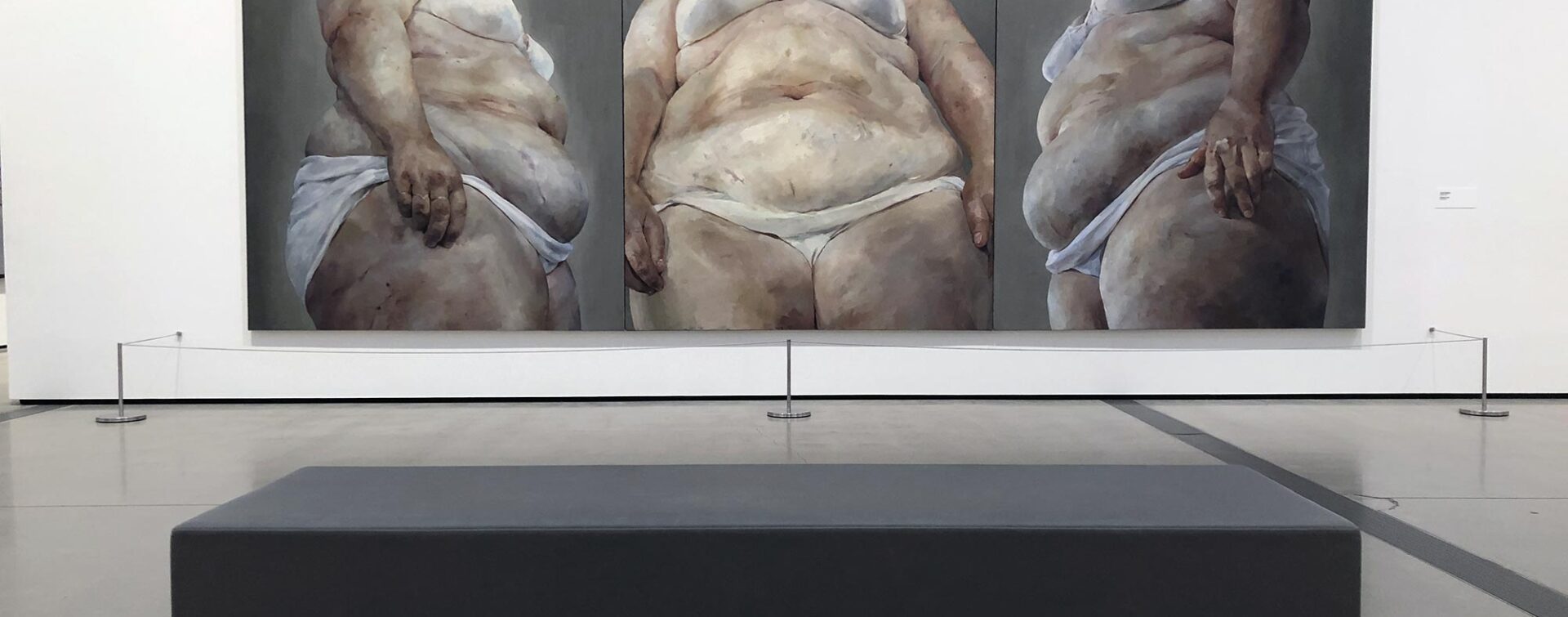
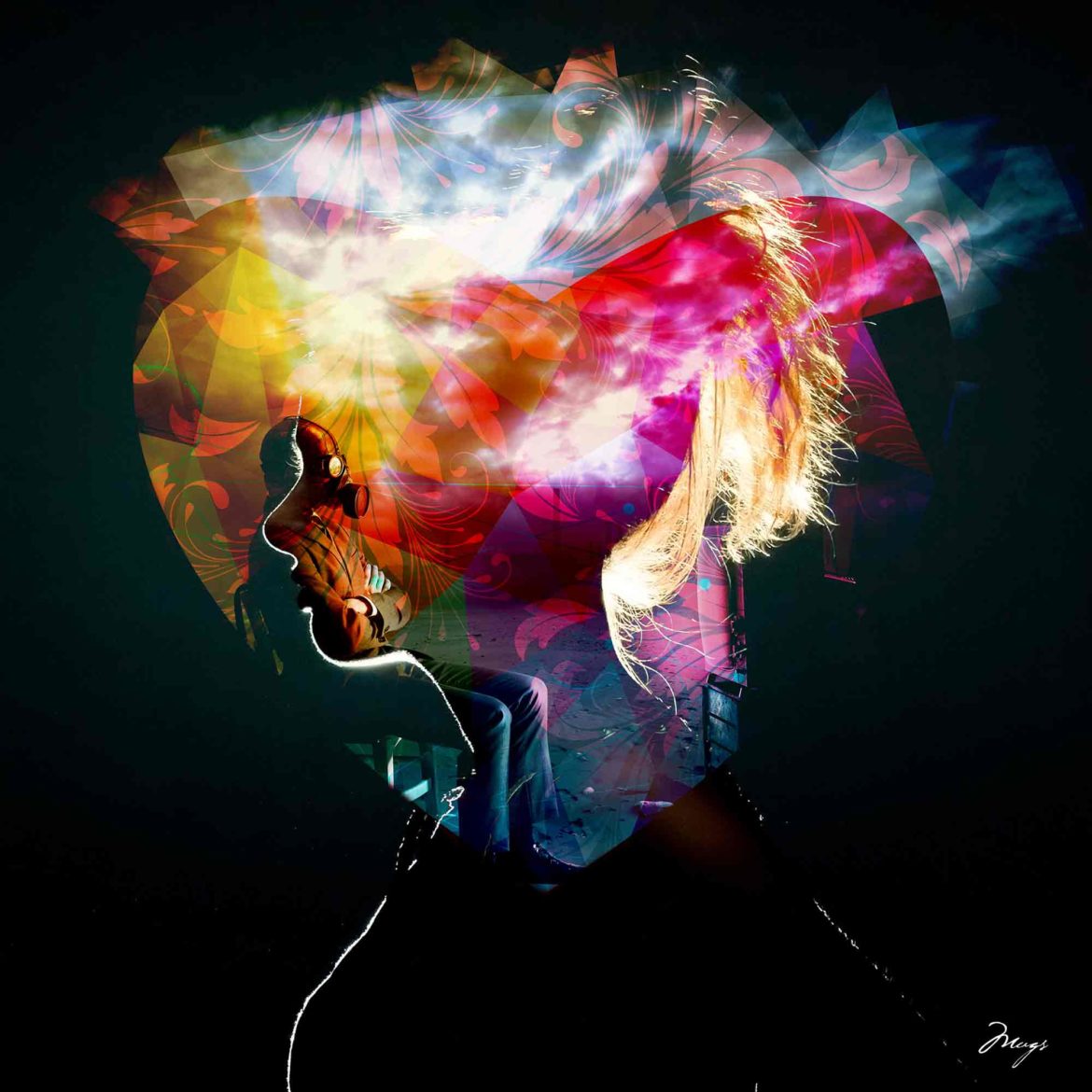

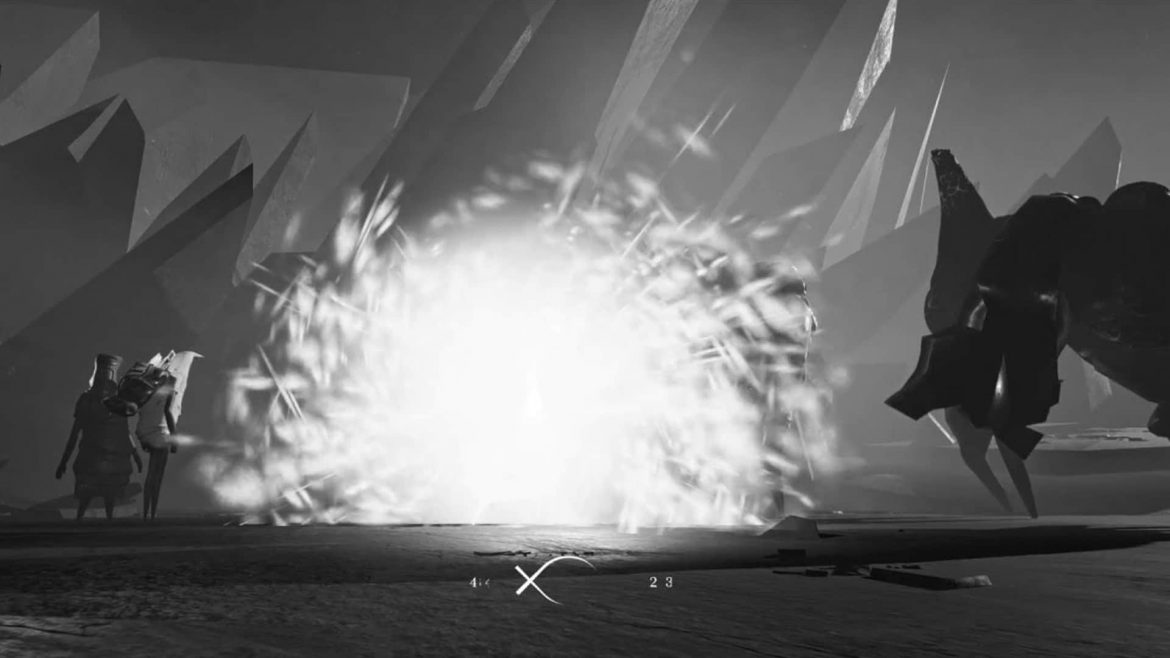
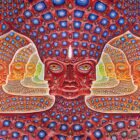


Anatomy of Despair: The Holy Bible